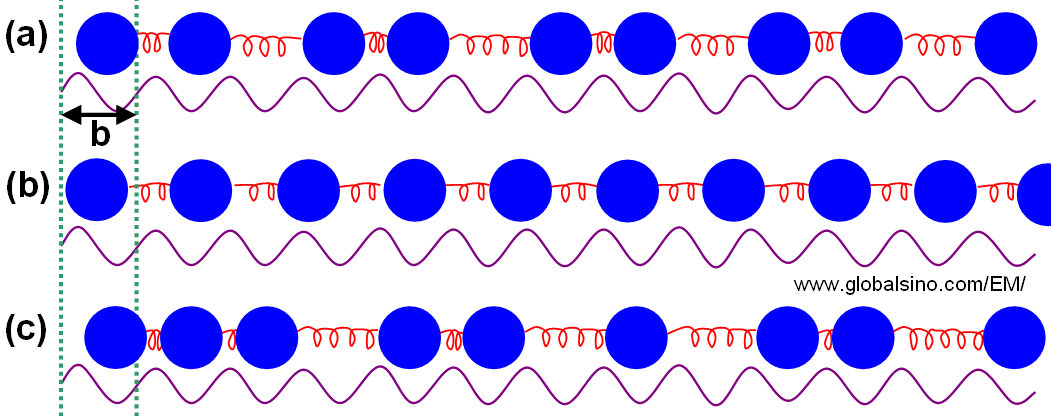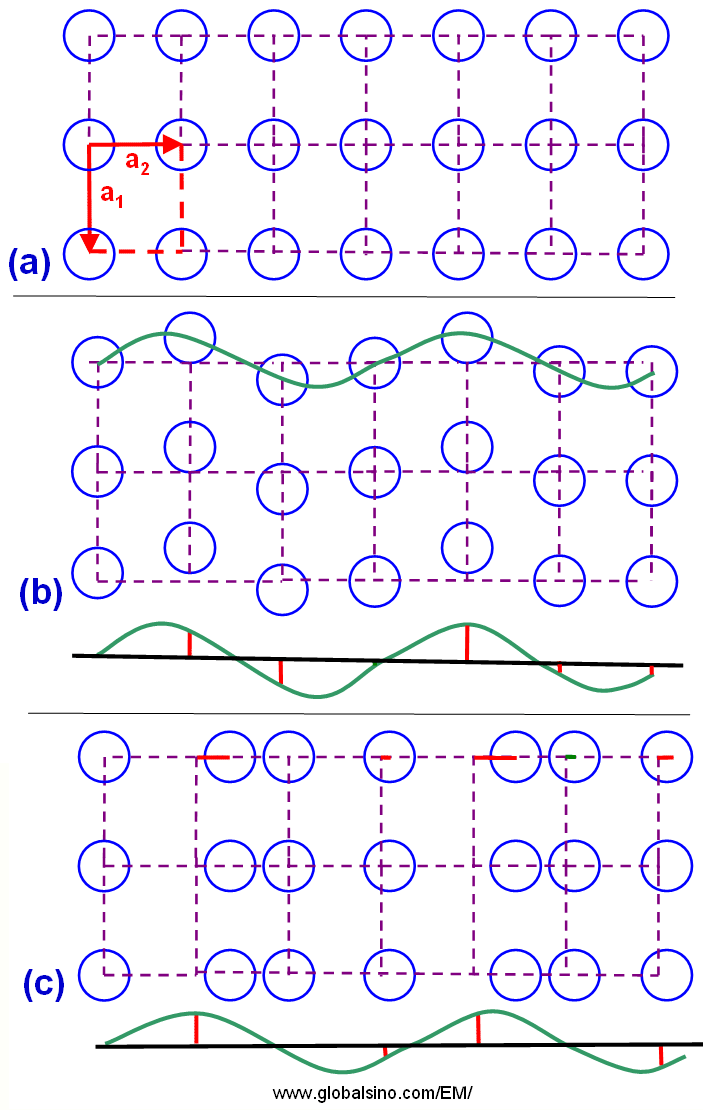=================================================================================
Incommensurate modulated structures have an average periodic structure, but the atoms are periodically modulated based on a modulation function with a period that is incommensurate to the periodicity of the basic structure. That means the real structure is not periodic.
There are mainly three types of modulations: i) The displacive modulation which results in the atoms shifted from their basic structure positions; ii) The occupational modulation which affects the occupancy of atomic sites by atoms or vacancies; iii) The modulation of ADPs (atomic displacement parameters), which affects the displacement of the atoms about their time-averaged positions. However, in the real structures the modulation can be a combination of the above modulations.
In one dimensional (1-D) FVdM (Frank and Van der Merwe) model in Figure 3492a, the atoms connected with the harmonic springs, representing a periodic potential, interact with each other with period b. The Hamiltonian may be taken to be,
 ------------------------ [3492a] ------------------------ [3492a]

Figure 3492a. The 1-D FVdM model. The springs represent interactions between atoms:
(a) Commensurate structure, (b) incommensurate structure, and (c) chaotic structure.
where,
xn -- The position of the nth atom
In the case with a periodic potential V = 0, the harmonic term H would lead to a lattice constant a0, which, in general, would be incommensurable with b as shown in Figure 3492a (b). In a diffraction experiment one would observe Bragg spots (or sheets) at positions Q = 2πN/a0 (N is an integer). If the potential V is strong enough the lattice may tend to relax into a comrnensurate (C) structure where the average lattice spacing a is a simple rational fraction of the period b as shown in Figure 3492a (a).
Even in the case where the potential is not strong enough to force the chain into commensurability, the potential will still modulate the chain. The modulation functions are wave functions and the atoms will move towards the potential minima. The average period may be close to a simple commensurate value, but still be incommensurate. In the most general incommensurate structure the position of the nth atom may be given by, [1 - 2]
xn = na + α + f(na + α) --------------------------- [3492b]
where,
α -- A phase
f -- Continuous and periodic number with period b
a -- The average distance between atoms (generally different from a0)
f -- The modulation of the chain due to the potential
However, chaotic structures cannot be described by Equation 3492b, where the diffraction pattern is not made up of well-defined Bragg spots.
In two-dimensional (2-D) model, the displacements of the atoms from the positions in the basic structure towards the positions in the superstructure can have both longitudinal and transversal components as shown in Figure 3492b. The wave functions are characterized by a wave vector q giving the direction and wavelength of the wave. The components of q are given with respect to the basis vectors of the reciprocal lattice of the basic structure, Λ* = {a*1, a*2, a*3}, according to,
q = σ1a*1 + σ2a*2 + σ3a*3 ----------------------------- [3492c]

Figure 3492b. Schematic illustration of a 2-D basic structure (a), incommensurate
transversal (b) and longitudinal (c) modulated crystal structure.
[1] Janner A and Janssen T 1977 Phys. Rev. B 15 643.
[2] Aubry S 1979 Solitons and Condensed Matter Physics ed A R Bishop and T Schneider (Berlin: Springer-Verlag) p 264.
|
 ------------------------ [3492a]
------------------------ [3492a] 
